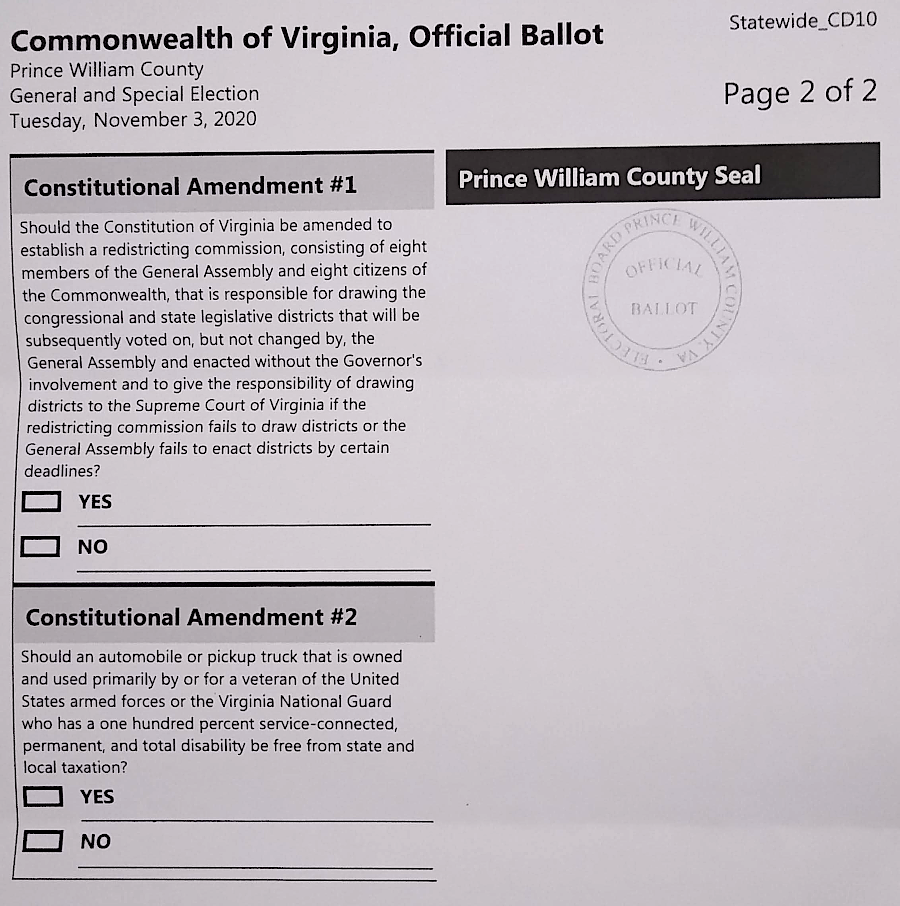
an amendment to alter the redistricting process was passed in 2019 and 2020, and additional approval by the voters was required for it to become effective
Source: OneVirginia2021, The Solution
The 1902 constitution had institutionalized segregation and restrictions on voting by black men (and, after 1920, black women). The Byrd Organization took full advantage of the restricted electorate. The 1928 amendments left intact the poll tax and administrative authorities to limit voter registration and to suppress the opposition vote.
However, decisions by the US Supreme Court in the 1950's and 1960's had made much of the language irrelevant. "Massive resistance" had failed, and the US Supreme Court had required redistricting to reflect the one person- one vote approach desired by residents west of the Blue Ridge before the Civil War, and by urban Virginians after the 1930's.
The General Assembly was under pressure to expand educational capacity, roads, and other public services as the post-WWII baby boom came of age. To meet voter demands, the "pay as you go" fiscal constraints that were the hallmark of the Byrd Organization and embedded in the 1928 constitutional amendments had to be altered.
In 1968, the General Assembly authorized a special committee to propose revised language for the state constitution, following the same process used in 1928 with the Prentis Commission rather than authorize a limited or general constitutional convention. Governor Godwin appointed the 11 members of the Commission on Constitutional Revision. Executive Director A. E. Dick Howard led the process efficiently, and the commission submitted its report in January 1969.
The Commission on Constitutional Revision recommended a wholesale change in the constitution, but doing that by having the General Assembly adopt amendments and submit them to the voters for approval. The alternative would have been to elect a separate set of delegates to a constitutional convention, which would draft a replacement for the current (1902 as amended) constitution. A separate convention involved most cost and more delay, plus less control by the legislators.
The General Assembly ended up approving four proposed amendments, done in two sessions separated by an election as required by the existing constitution. Three separate, controversial issues were presented as separate amendments from the main body of essentially a new constitution.
Major revisions that committed the state to protect the environment, to maintain free public elementary and secondary schools statewide, and to prohibit discrimination by race were not seen as threatening support for the rest of the changes so they were not split out for separate votes. Some proposals from the Commission on Constitutional Revision, such as giving more home rule authority to local cities and counties with at least 25,000 residents, were not approved by the General Assembly so they were not presented to the voters at all.
Question No. 1 on the ballot was approval of the main document. Question No. 2 eliminated the prohibition on lotteries. Questions No.2 and 3 authorized the state to issue general obligation bonds (after approval in a public referendum) and revenue bonds (with a referendum requirement), abandoning Gov. Harry Byrd's "pay as you go" approach to funding capital improvements such as roads and schools.
Advocates of the revisions mobilized a major bipartisan effort to generate public support for the revision, in part because Maryland voters had rejected a proposed constitution just recently. Splitting out the three controversial proposals minimized the potential charge that the legislature had dumped a "take it or leave it" proposal on the voters, which had led to the Maryland defeat. The basic message was that the amendments would "Bring government closer to the people." Voters approved all four proposals in November, 1970, 63% in favor of the least-popular provision on lotteries to 72% in favor of the main document.
The amendments altered the state constitution more substantially than the revisions under Gov. Harry Byrd in 1928. Though technically the voters approved just amendments in 1970, the result is typically described as a separate 1971 constitution. With 18,000 words, it had about half of the total in the version it replaced when the new constitution went into effect on July 1, 1971.1
The Commission on Constitutional Revision (CCR) had originally included a "home rule" provision to eliminate the constraints of the Dillon Rule on the authority of local jurisdictions. The draft language was deleted by the General Assembly before being sent to the voters for approval.2
Nearly every General Assembly has considered new proposals for amending the 1971 constitution, but few make it through the process. Constitutional amendments must be approved twice by the General Assembly, with an election for the House of Delegates occurring between those two votes. Governors have no authority to veto such proposed changes. If approved without modification a second time, then voters must approve the amendment in a statewide referendum.
Amendments in 180 and 1994 enhanced the legislature's ability to react to vetoes by the governor. There is now an automatic "veto session" scheduled after the regular session has closed. That session, typically lasting just one day, allows the General Assembly an opportunity to override vetoes made near the end of the regular session or after it adjourned. The legislators can also respond to proposed amendments and line-item vetoes of budget items.3
An amendment added to the 1971 constitution in 2006 was the first significant change to Virginia's Bill of Rights since it was adopted in 1776. The "marriage amendment" was designed to limit the legal rights of people who identified as GLBTQI:4
A US Supreme Court decision, Obergefell v. Hodges, legalized same-sex marriage throughout the United States in 2015. Until the state constitution is altered, however, the unenforceable ban will remain as Section 15-A in Article I. Bill of Rights.
The 2019 General Assembly approved an amendment that would affect the redistricting process. If approved a second time without any changes by the 2020 legislature and then by the voters in November 2020, the General Assembly would have far less control over redrawing the boundaries of legislative districts after the 2020 Census.5

an amendment to alter the redistricting process was passed in 2019 and 2020, and additional approval by the voters was required for it to become effective
Source: OneVirginia2021, The Solution

two constitutional amendments were on the ballot in 2020